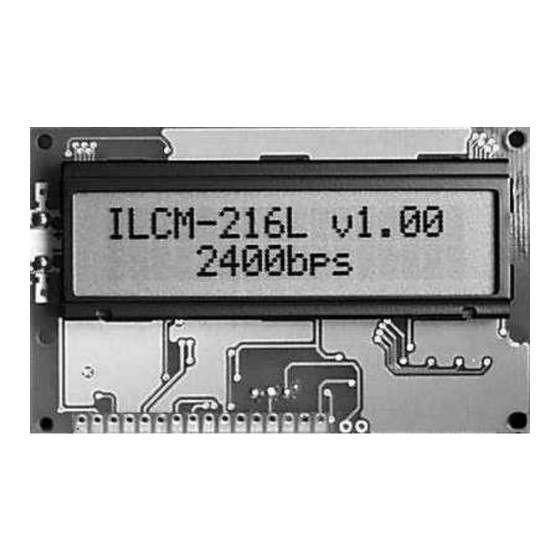
Summary of Contents for Scott Edwards Electronics ILM-216
- Page 1 Distributed by: www.Jameco.com 1-800-831-4242 The content and copyrights of the attached material are the property of its owner.
-
Page 2: Table Of Contents
Warranty Scott Edwards Electronics, Inc. warrants this product against defects in materials and workmanship for a period of 90 days. If you discover a defect, we will, at our option, repair, replace, or refund the purchase price. Return the product with a description of the problem. -
Page 3: Pinout Of The Ilm-216
ILM-216 • v1.2 • 07/00 • pg 2 Pinout of the ILM-216 Connections to the ILM-216 are made through a row of solder pads located at the bottom edge of the module (figure 1). Table 1 lists the pads’ functions. -
Page 4: Basic Operation
Figure 3. Connecting to PC serial port, BASIC Stamps. Basic Operation Connect serial input and power to the ILM-216 as shown in the previous sections. Make sure that pins 6 and 7 are not connected together (configuration/test mode). If they are, remove power, disconnect pins 6 and 7, and restore power. - Page 5 User’s Manual ILM-216 • v1.2 • 07/00 • pg 4 Table 2. Display Control Codes Function Code ASCII Null (ignored prior to buffer) ctrl-@ Cursor home ctrl-A Hide cursor ctrl-D Show underline cursor ctrl-E Show blinking-block cursor ctrl-F Bell (pulse piezo-buzzer output)
- Page 6 • Transfer Data from EEPROM (ESC E n) The ILM-216 has 64 bytes of EEPROM, which may be used to store configuration data, such as text for a startup screen or default patterns for the first six custom characters (ASCII 128 through 133). Using the EEPROM instruction, you can transfer that data from EEPROM to the display.
-
Page 7: Configuration Eeprom
To download data to the EEPROM, connect the ILM-216 to a PC as shown in figure 3. Temporarily connect pins 6 and 7 of the ILM-216 together, and power the unit. It will display the screen shown in figure 1 (with some possible variations in the text). The ILM-216 is waiting to receive 64 bytes that it will copy to EEPROM. -
Page 8: Program Examples
Any computer/programming language that can produce serial output (1200 to 9600 bps, N81) can talk to the ILM-216. The examples here are in BASIC, chosen because of its popularity and readability. (A C programmer can readily understand BASIC, but a BASIC programmer generally cannot read C.) These examples are meant to illustrate only the fundamentals. -
Page 9: Dimensions And Specifications
' Note: QBASIC is the BASIC interpreter that Microsoft shipped with most versions of ' DOS. An alternative is PowerBASIC or First BASIC, from www.powerbasic.com (or go ' to www.seetron.com and follow the link from the ILM-216 support page). ' Program assumes ILM-216 set for 2400 bps (factory default), connected ' as shown in figure 3.


Need help?
Do you have a question about the ILM-216 and is the answer not in the manual?
Questions and answers